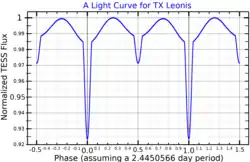TX Leonis, also known by its Flamsteed designation 49 Leonis, is a triple star system that includes an eclipsing binary, located in the constellation Leo. It was discovered to be a variable star, showing eclipses, by Ernst-Joachim Meyer in 1933.[16] The apparent magnitude of TX Leonis ranges between 5.66 and 5.75, making it faintly visible to the naked eye for an observer located well outside of urban areas.[3] The star's brightness drops by 0.09 and 0.03 magnitudes during the primary and secondary eclipses respectively, and neither the primary nor the secondary eclipse is total.[6]
TX Leonis is a triple star, consisting of magnitude 8.1 star (component B) separated by 2 arc seconds from the brighter eclipsing pair (components Aa and Ab).[17][18] Although orbital motion has not been detected, the companion shares a common proper motion with the primary star and is at approximately the same distance.[14]
Both stars comprising the eclipsing binary are main sequence stars. Of those two stars, star Aa has been assumed to be 8 times more luminous than star Ab,[7] although newer estimates give the luminosities as 83 L☉ and 6 L☉ respectively.[10]
References
- ↑ "MAST: Barbara A. Mikulski Archive for Space Telescopes". Space Telescope Science Institute. Retrieved 8 January 2023.
- 1 2 3 4 5 van Leeuwen, Floor (13 August 2007). "Validation of the new Hipparcos reduction". Astronomy & Astrophysics. 474 (2): 653–664. arXiv:0708.1752. Bibcode:2007A&A...474..653V. doi:10.1051/0004-6361:20078357. eISSN 1432-0746. ISSN 0004-6361.
- 1 2 3 Samus', N. N.; Kazarovets, E. V.; Durlevich, O. V.; Kireeva, N. N.; Pastukhova, E. N. (2017). "General catalogue of variable stars: Version GCVS 5.1". Astronomy Reports. 61 (1): 80. Bibcode:2017ARep...61...80S. doi:10.1134/S1063772917010085. S2CID 125853869.
- ↑ Giuricin, G.; Mardirossian, F.; Mezzetti, M. (February 1984). "Synchronization in eclipsing binary stars". Astronomy and Astrophysics. 131: 152–158. Bibcode:1984A&A...131..152G.
- 1 2 Bilir, S.; Ak, T.; Soydugan, E.; Soydugan, F.; Yaz, E.; Filiz Ak, N.; Eker, Z.; Demircan, O.; Helvaci, M. (October 2008). "New absolute magnitude calibrations for detached binaries". Astronomische Nachrichten. 329 (8): 835. arXiv:0806.1290. Bibcode:2008AN....329..835B. doi:10.1002/asna.200811002. S2CID 6131326.
- 1 2 Avvakumova, E. A.; Malkov, O. Yu.; Kniazev, A. Yu. (October 2013). "Eclipsing variables: Catalogue and classification". Astronomische Nachrichten. 334 (8): 860. Bibcode:2013AN....334..860A. doi:10.1002/asna.201311942. hdl:10995/27061.
- 1 2 3 4 Srivastava, J. B.; Kandpal, C. D. (January 1968). "Photoelectric elements of the eclipsing binary TX Leo". Bulletin of the Astronomical Institute of Czechoslovakia. 19: 381. Bibcode:1968BAICz..19..381S.
- 1 2 Chamberlin, Carl; McNamara, D. H. (October 1957). "The Orbit of the Eclipsing Binary TX Leonis". Publications of the Astronomical Society of the Pacific. 69 (410): 462. Bibcode:1957PASP...69..462C. doi:10.1086/127125. S2CID 120162415.
- 1 2 3 4 Dryomova, G. N.; Svechnikov, M. A. (April 2007). "Effect of tidal evolution in determining the ages of eclipsing-variable early main sequence close binary systems". Astrophysics. 50 (2): 239–253. Bibcode:2007Ap.....50..239D. doi:10.1007/s10511-007-0023-9. S2CID 121459015.
- 1 2 3 4 De Greve, J. P.; Vanbeveren, D. (1980). "Close Binary Systems Before and after Mass Transfer - a Comparison of Observations and Theory". Astrophysics and Space Science. 68 (2): 433. Bibcode:1980Ap&SS..68..433D. doi:10.1007/BF00639709. S2CID 123281741.
- 1 2 3 4 Anders, F.; Khalatyan, A.; Chiappini, C.; Queiroz, A. B.; Santiago, B. X.; Jordi, C.; Girardi, L.; Brown, A. G. A.; Matijevič, G.; Monari, G.; Cantat-Gaudin, T.; Weiler, M.; Khan, S.; Miglio, A.; Carrillo, I.; Romero-Gómez, M.; Minchev, I.; De Jong, R. S.; Antoja, T.; Ramos, P.; Steinmetz, M.; Enke, H. (2019). "Photo-astrometric distances, extinctions, and astrophysical parameters for Gaia DR2 stars brighter than G = 18". Astronomy and Astrophysics. 628: A94. arXiv:1904.11302. Bibcode:2019A&A...628A..94A. doi:10.1051/0004-6361/201935765. S2CID 131780028.
- ↑ Abt, Helmut A.; Boonyarak, Chayan (November 2004). "Tidal Effects in Binaries of Various Periods". The Astrophysical Journal. 616 (1): 562–566. Bibcode:2004ApJ...616..562A. doi:10.1086/423795.
- ↑ Pan, K. -K (1997). "Synchronization in the early-type detached binary stars". Astronomy and Astrophysics. 321: 202. Bibcode:1997A&A...321..202P.
- 1 2 Tokovinin, Andrei (2018-03-01). "The Updated Multiple Star Catalog". The Astrophysical Journal Supplement Series. 235 (1): 6. arXiv:1712.04750. Bibcode:2018ApJS..235....6T. doi:10.3847/1538-4365/aaa1a5. ISSN 0067-0049. S2CID 119047709.
- ↑ "49 Leo -- Eclipsing Binary". SIMBAD. Centre de données astronomiques de Strasbourg. Retrieved 2023-01-08.
- ↑ Meyer, Ernst-Joachim (May 1933). "Neuer heller Bedeckungsveränderlicher 61.1933 Leonis". Astronomische Nachrichten. 248 (23): 419. Bibcode:1933AN....248..419M. doi:10.1002/asna.19332482308.
- ↑ Eggleton, P. P.; Tokovinin, A. A. (September 2008). "A catalogue of multiplicity among bright stellar systems". Monthly Notices of the Royal Astronomical Society. 389 (2): 869–879. arXiv:0806.2878. Bibcode:2008MNRAS.389..869E. doi:10.1111/j.1365-2966.2008.13596.x. S2CID 14878976.
- ↑ Mason, Brian D.; Hartkopf, William I.; Wycoff, Gary L.; Rafferty, Theodore J.; Urban, Sean E.; Flagg, Laura (December 2004). "Speckle Interferometry at the US Naval Observatory. X.". The Astronomical Journal. 128 (6): 3012–3018. Bibcode:2004AJ....128.3012M. doi:10.1086/425532.
